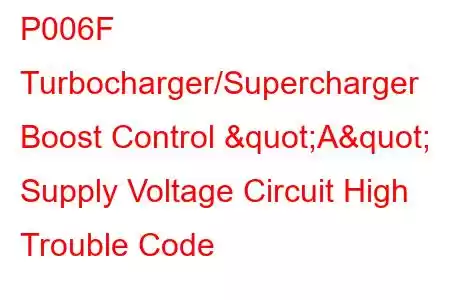P006F Turbo/Supercharger Boost Control A Voltage High
OBD-II Trouble Code Technical Description
Turbocharger/Supercharger Boost Control A Supply Voltage Circuit High
What does that mean?
This is a generic powertrain diagnostic trouble code (DTC) and typically applies to OBD-II vehicles. That may include but is not limited to vehicles from Chevy (Chevrolet), GMC (Duramax), Dodge, Ram (Cummins), Isuzu, Ford, Vauxhall, VW, etc. Although generic, the exact repair steps may vary depending on year, make, model and powertrain configuration.
Turbochargers, superchargers, and any other forced induction (FI) systems for that matter, use energy generated from the engine (i.e.: exhaust pulses, belt-driven screw-type, etc.) to increase the amount of air that can be introduced to the combustion chamber (increased volumetric efficiency).
Given the fact that, in forced induction systems, intake pressures need to vary and need to be adjusted according to the operator's many power needs. Manufacturers use a form of boost control valve (AKA, Waste-gate, boost control solenoid, etc.), which is monitored and controlled by the ECM (Engine Control Module), to make sure the air/fuel mixture is stoichiometric (ideal). It does this, by mechanically adjusting the "vanes" in the charger. These vanes are responsible for adjusting the amount of boost (intake pressure) to the chamber. As you can imagine, a problem within the boost controlling component, may cause drivability issues. The problem is, when the ECM loses control of the boost, typically, your vehicle goes into "limp" mode to avoid engine damage (via over/under-boost conditions causing a potentially damaging rich and/or lean A/F mixture).
As far as the letter "A" goes here, it could be to distinguish a connector, wire, circuit group, etc. That said, the manufacturer's specifications is the best resource you could have for this.
The ECM illuminates the check engine light (CEL) with P006F and related codes when it detects a fault within the boost control system.
The P006F DTC is activated when the ECM (Engine Control Module) detects a higher than expected electrical value within the "A" boost control supply voltage circuit.
A turbocharger and related components:
What is the severity of this DTC?
Severity is set to moderate-high. When there is a problem within the forced induction system, you risk altering the air/fuel ratio. Which, could, in my opinion will, cause significant engine damage if ignored or left unattended. Not only do you run the risk of damaging internal engine components but you will be getting terrible fuel mileage in the process, so it is in your best interest to repair any faults within the forced induction system.
What are some of the symptoms of the code?
Symptoms of a P006F trouble code may include:
Low, erratic and/or abnormal power levels Overall poor drivability Decrease in throttle response Trouble driving up hills Vehicle enters "limp" mode (i.e. fail-safe) Intermittent driveability symptomsWhat are some of the common causes of the code?
Causes for this P006F code may include:
Defective or damaged boost control solenoid (e.g. lever stuck, broken, bent, etc.) Corrosion causing high resistance (E.G: Connectors, pins, grounds, etc.) Wiring issue (e.g. Frayed, open, short to power, short to ground, etc.) ECM (Engine Control Module) internal issue Excessive exhaust soot in vanes of charger, causing stagnant high/low/incorrect boost levels Boost control module issue Exhaust leakWhat are some P006F troubleshooting steps?
Basic Step #1
An important note to remember is that, forced induction systems generate a dangerous amount of heat and will seriously burn your skin if unprotected and/or engine is cool. That said, visually locate the boost control solenoid
Read: 50


